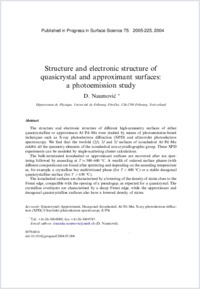Structure and electronic structure of quasicrystal and approximant surfaces: a photoemission study
- Naumović, Dusanka Department of Physics, University of Fribourg, Switzerland
-
15.07.2004
Published in:
- Progress in Surface Science. - 2004, vol. 75, no. 3-8, p. 205-225
quasicrystal
approximant
decagonal
icosahedral
Al–Pd–Mn
X-ray photoelectron diffraction (XPD)
ultraviolet photoelectron spectroscopy (UPS)
English
The structure and electronic structure of different high-symmetry surfaces of either quasicrystalline or approximant Al–Pd–Mn were studied by means of photoemission-based techniques such as X-ray photoelectron diffraction (XPD) and ultraviolet photoelectron spectroscopy. We find that the twofold (2f), 3f and 5f surfaces of icosahedral Al–Pd–Mn exhibit all the symmetry elements of the icosahedral non-crystallographic group. These XPD experiments can be modeled by single-scattering cluster calculations. The bulk-terminated icosahedral or approximant surfaces are recovered after ion sputtering followed by annealing at T≈500–600 °C. A wealth of ordered surface phases (with different compositions) are found after sputtering and depending on the annealing temperature as, for example, a crystalline bcc multitwinned phase (for T<400 °C) or a stable decagonal quasicrystalline surface (for T>650 °C). The icosahedral surfaces are characterised by a lowering of the density of states close to the Fermi edge, compatible with the opening of a pseudogap, as expected for a quasicrystal. The crystalline overlayers are characterised by a sharp Fermi edge, while the approximant and decagonal quasicrystalline surfaces also have a lowered density of states.
- Faculty
- Faculté des sciences et de médecine
- Department
- Département de Physique
- Language
-
- English
- Classification
- Physics
- License
-
License undefined
- Identifiers
-
- RERO DOC 4246
- DOI 10.1016/j.progsurf.2004.05.004
- Persistent URL
- https://folia.unifr.ch/unifr/documents/299764
Statistics
Document views: 149
File downloads:
- Texte intégral: 367
